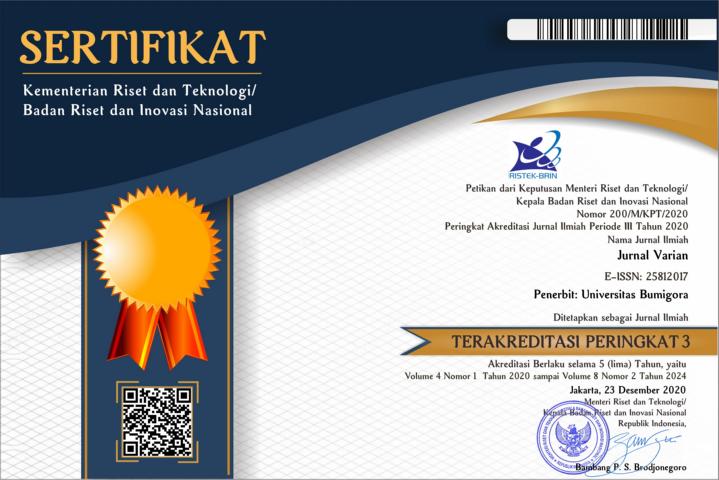PEMODELAN DATA DERET WAKTU DENGAN AUTOREGRESSIVE INTEGRATED MOVING AVERAGE DAN LOGISTIC SMOOTHING TRANSITION AUTOREGRESSIVE
DOI:
https://doi.org/10.30812/varian.v1i1.50Keywords:
ARIMA, LSTAR, InflationAbstract
Time series analysis is a statistical analysis that can be applied on data related to time. Modeling of time series data is widely associated with the process of forecastinga certain characteristics in the coming period. Most inflation data modeling is done using a linear time series models such as Autoregressive Integrated Moving Average (ARIMA). In fact only the ARIMA model can be applied to models of linear time series data. Models of ARIMA hasn't been able to give good results when the data being analyzed is a nonlinear time series data. The inflation data, data that has a tendency to form patterns of nonlinear data so the application of nonlinear time series models can be done on the inflation data. Logistic model Smooting Threshold Autoregressive (LSTAR) is a time series model can be applied to data that follow nonlinearmodel. LSTAR then developed on data-financial and economic data such as inflation. If the inflation data are modelled with expected LSTAR approach can get a better result because already done smoothing in it. This research aims to know the best model that can be used to perform data modeling inflation. The results showed that the results of the comparison of the MSE and the RMSE for the model of ARIMA and LSTAR. Based on these results it is known that the model MSE has a value and LSTAR RMSE smaller compared to ARIMA. So the model more appropriate LSTAR is used to model the data of inflation
References
[2] J. Li, “Bootstrap Prediction Intervals for SETAR models,†Int. J. Forecast., hal. 320– 332, 2011.
[3] S. Bekiros, “A robust Algorithm for Parameter Estimation in Smooth Transition Autoregressive Models,†Econ. Lett., hal. 36– 38, 2009.
[4] J. B. Lin, C. . Liang, dan M. . Yeh, “Examining Nonlinier Dynamics of Exchange rates and Forecasting Performance based on the Exchange rate parity of four Asian Economies,†Jpn. World Econ., hal. 79–85, 2011.
[5] S. Rohani, F. Yusof, dan I. L. Kane, “Nonlinear Smooth Transition Auotoregressive (STAR)-Type Modelling and Forecasting on Malaysia Airlines (MAS) Stock Returns,†J. Teknol., vol. 11, hal. 137–145, 2015.
[6] D. Rosadi, Analisis Ekonometrika dan Runtun Waktu Terapan dengan R. Yogyakarta: ANDI, 2011.
[7] T. Terasvirta, C. . Lin, dan C. Granger, “Power of The Neural Network Linearity Test,†J. Time Ser. Anal., hal. 209–220, 1993.
[8] T. H. Lee, H. White, dan C. Granger, “Testing for Neglected Nonlinearity in Time Series Model,†J. Econom., hal. 269–290, 1993.
Downloads
Published
Issue
Section
How to Cite
Most read articles by the same author(s)
- Ni Putu Nanik Hendayanti, Maulida Nurhidayati, Perbandingan Metode Seasonal Autoregressive Integrated Moving Average (SARIMA) dengan Support Vector Regression (SVR) dalam Memprediksi Jumlah Kunjungan Wisatawan Mancanegara ke Bali , Jurnal Varian: Vol. 3 No. 2 (2020)
- Luh Putu Safitri Pratiwi, Ni Putu Nanik Hendayanti, I Ketut Putu Suniantara, Perbandingan Pembobotan Seemingly Unrelated Regression – Spatial Durbin Model Untuk Faktor Kemiskinan Dan Pengangguran , Jurnal Varian: Vol. 3 No. 2 (2020)
- Ni Putu Ni Putu Nanik Hendayanti, Maulida Nurhidayati, PEMODELAN JUMLAH UANG BEREDAR DAN INFLASI NASIONAL DENGAN VECTOR ERROR CORRECTION MODEL (VECM) , Jurnal Varian: Vol. 1 No. 1 (2017)
- Gede Suwardika, I Ketut Putu Suniantara, Ni Putu Nanik Hendayanti, Ketidaktepatan Waktu Kelulusan Mahasiswa Universitas Terbuka dengan Metode Boosting Cart , Jurnal Varian: Vol. 2 No. 2 (2019)
- Ni Putu Nanik Hendayanti, I Ketut Putu Suniantara, Maulida Nurhidayati, Penerapan Support Vector Regression (Svr) Dalam Memprediksi Jumlah Kunjungan Wisatawan Domestik Ke Bali , Jurnal Varian: Vol. 3 No. 1 (2019)
- Siti Soraya, Maulida Nurhidayati, Baiq Candra Herawati, Anthony Anggrawan, Lalu Ganda Rady Putra, Didiharyono D, Forecasting Foreign Tourist Visits to West Nusa Tenggara Using ARIMA Method , Jurnal Varian: Vol. 5 No. 1 (2021)
- Ni Putu Nanik Hendayanti, Gusti Ayu Made Arna Putri, Maulida Nurhidayati, Ketepatan Klasifikasi Penerima Beasiswa STMIK STIKOM Bali dengan Hybrid Self Organizing Maps dan Algoritma K-Mean , Jurnal Varian: Vol. 2 No. 1 (2018)





















